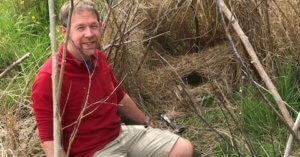
Richard Edwards, EIT Bachelor of Education – primary, teacher educator gets hands on learning to teach outdoors.
EIT is teaching its teachers to use the outdoors to further their teaching success.
In a week that saw EIT announced as a corporate guardian of the Hawke’s Bay Biodiversity group, the tertiary institute has brought together environmental educators from around the country to explore ways to incorporate education outdoors into an innovative learning environment.
At an overnight hui held at Mangarara Eco Lodge in Patangata, Central Hawke’s Bay, 40 educators shared ideas on how to use the outdoors as a teaching tool.
“We want to be sure that EIT students and practicing teachers have the learning experiences to equip them with the tools, knowledge and confidence to incorporate the use of outdoor learning environments into their teaching,” says Professor Natalie Waran, who is spearheading the initiative for EIT.
“Our overall goal is to improve awareness and understanding of the environment across the whole community by promoting the conservation and sustainable use of natural resources, leading to a better environment and a better quality of life.
“We see it is critical for the whole community to understand the biodiversity issues facing our region, and in fact, the world.”
Partnering EIT to organise the workshop were the Cape to City team from Hawke’s Bay Regional Council and the Air New Zealand Environment Trust.
The group were addressed by Ruud Kleinpaste, AirNZ Environment Trust chair by video link. He spoke on the importance of developing future educators who were confident and skilled in providing education in an outdoor environment. He acknowledged EIT for taking a leadership role in helping to achieve this in Hawke’s Bay.
The first day included discussion and hands on outside learning that saw the participants getting dirty. “We were definitely walking the talk,” says Prof. Waran.
Dame Anne Salmond, Professor in Māori Studies, Māori and Pacific Studies, from the University of Auckland introduced the work of Wild Lab. Dame Anne and her husband Jeremy, founded the Waikereru Ecosanctuary. The Ecosanctuary is a haven for rare and endangered species of native birds, plants and animals inland from Gisborne city.
Together with Peter and Ellen Jarrat, award winning creatives, the Salmonds have created Wild Lab where artist-scientists of all ages are involved in multi-sensory activities and challenges.
Other sessions were led by Professor Bronwen Cowie, director of the Wilf Malcolm Institute of Educational Research at Waikato University. She presented national and international perspectives on using the environment as a context for learning with the aim of providing quality educational outcomes.
Esther Kirk, Environschools’ national manager assisted by regional coordinator, Sally Chandler spoke on that organisation’s kaupapa.
Department of Conservation’s North Island education regional coordinator, Ben Moorehouse outlined the department’s environmental education perspective.
In addition, Mangarara Farm owners, Greg and Rachel Hart shared Mangarara Farm’s approach to regenerative agriculture that embraces connected landscape and people.
On the second day, EIT Bachelor of Teaching primary and early childhood teams brainstormed how they could incorporate all they had learned about using outdoor spaces into their teaching delivery.
